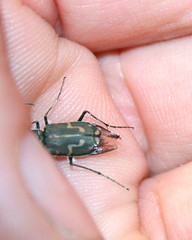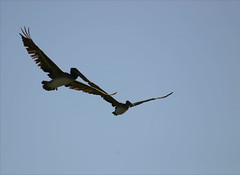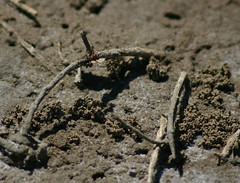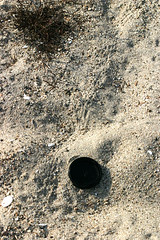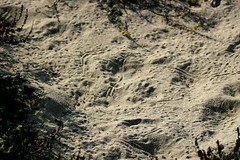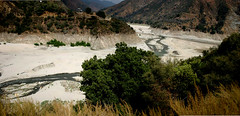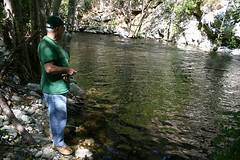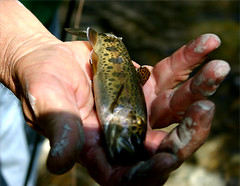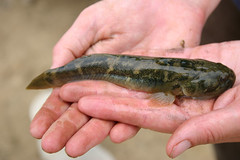Monday, August 29, 2005
Mugu-upper-marsh
The upper marsh gives one the impression of being alone. The silence is beautiful. The bees quietly buzz 10 centimeters above around the ground. There is so much to learn up here. Water seeps from the hills during the rains and salt water squeezes through the sands from the ocean. I find new animals all the time. Shrews, six types of dragon flies, tiny velvet ants....
Deformed-C-s.f.
This is the second deformed Cicindela I have found at Mugu. The first one was Cicindela hemorrhagica this one is Cicindela senilis frosti.
Could they have become deformed because of the stress of the storms from last winter? or from water causing objects to deform their pupal cell? or could be it because of some substance in the pore water?
These two beetles were smaller then normal which usually indicates poor nutrition... what could have happened? Could they have had conditions so stressful during their larval stage to force them into complete metamorphosis before proper development?
The numbers of deformed wild insects are usually much smaller then the commercially grown insects like meal worms or crickets. I am surprised to find living tigers with such deformities! They were so easy for me to catch them... a bird would have had them for a small snack.
Pelis-at-Mugu
Brown pelicans float on the wind above the water looking for tasty bits just near the surface of the water.
When they see something... they fold their wings, face downward, and dive.
Gosh! To be able to do that!
Otitidea-in-tiger-burrows
Dancing about the upper marsh is a fly - an Otitidae fly that lays its eggs in the burrows... Whose burrows? Well, there are Halicitidae bees and Cicindela beetles....
It struts and flips its wings, it scurries sideways and drops out of sight into a hole of .... which insect? perhaps both????
Can you find the fly with the pointed face?
Wednesday, August 24, 2005
Malaise trap in the forest

The Malaise trap is set up in the forest of the San Gabriel Mountains. This is the West Fork site about 1 and 2/10 mile from the locked gate. The trap is about five meters from the River water's edge. So far, moths, flies, spiders, grasshoppers, mosquitoes, midges, wasps, and black flies have found their way up into the head of the trap. I will collect one more sample from this area before I move it to the next site in the North Fork.
The drop traps in the area are collecting ants, wasps, beetles, flies, an occational baby lizzard, moths and lots of spiders.
What could be the differences between the Ventura Marsh at Mugu and the Riparian brush in the Mountians?
Sunday, August 14, 2005
who's-that-footprint
I found this trail in the sand dunes near the firing range of Mugu. I know who made his trail. Do you? I threw my lens cap on the sand to show the size of the animal. Here are some hints: it's not a vertebrate, it walks side ways, and some people make ____cakes out of them (although, I doubt this species).
Can you count the number of animals in the next picture? there are three mammals and one reptile.
Can you count the number of animals in the next picture? there are three mammals and one reptile.
footprint-2
Many many animals live in the dunes of Mugu. Sand dunes and the beaches next to them have 'wrack' thrown up on to them from storms. The plants adapted to the sand, heat and salty water create a netting to hold the sand and they are homes to these vertebrates and invertebrates. Sometimes the only way to know who lives here is to look for 'scat,' bones, burrows, and footprints.
Way too many people

At the base of the West Fork of the San Gabriel River, many people gather to swim, and pick-nic. My son asked if they knew that they would be drinking that water.... I doubt that that crosses their minds.
They aslo bring charcol and make small fires to cook their hamburgers. Sometimes, they do this under a tree. I guess to get out of the sun, but I doubt that they think about the fire escaping into the very dry brush all around them....
In an earlier post I took a picture of a roll of toilet paper next to the river left by pick-nicers. They also leave tons of diapers.
Wednesday, August 10, 2005
Dry-San-Gabriel-bed
After tons of silt and sand were scraped from the bottom of the River behind the Morris Dam (up-stream of the San Gabriel Dam), many more tons will have to be moved.
Good-fishin-hole
Chuck, from the Fisheries Resource Volunteer Corps, has taken on the task of looking after a part of the San Gabriel River. He helps keeps the area free of trash from visitors, conducts classes in the proper etiquette in Forest use, and helps other groups enjoy this resource. This is one of his favorite fishing spots, "Fishing is really all about calories" said Chuck, " Fish have to find a spot where they can hold still and still eat ... other wise they can starve, ware themselves out, or both... Fish hang out in areas where the fast moving water and the still water come together... If you were a gold miner that's where the gold would be, too."
wild-trout
These trout were stocked in the San Gabriel River a hundred years ago. In this part of the River you can only catch and release. The pattern of spots on this fish is beautiful! As the fish gets older and bigger, the tanins in the water darken the fish.
Mugu morning and the Malaise traps

Tuesday, the drop traps were emptied and three Malaise traps were set around the parameter of the two IOE sites. The traps are circled and you can see from the size of the center trap by comparing it to the Hummer, which is about eight meters away.
The mist was still hanging above the mountains that morning. Birds were in small flocks here and there. The sound of the waves were behind me. There were a few damsel flies I had not seen before. flitting about. Tomorrow, I will bring my net and see if I can catch and identify them.
This is why I love Mugu.
Sunday, August 07, 2005
Mugu-fish
This is long-jawed mudsucker (Gillichthys mirabilis). This little guy was caught in the crab trap set to catch crabs. It is baited with dry dog food which sometimes entices intrepid mice. ~ The mice have to dodge birds, rattle snakes, in-coming tides, lots of mud, and large distances from dry land where they make their homes.
We catch, measure, and release animals. This mudsucker got to have its picture taken.
Beautiful!
We catch, measure, and release animals. This mudsucker got to have its picture taken.
Beautiful!
California marsh plant community

The Atriplex has been seen more in the mudflats and marsh recently. -It is salt tolerant. The Salicornia is in bloom and so is the Frankenia. Frankenia has beautiful pinky purple flowers that the various bees and bee flies come to feed. Salicornia flowers are small yellow/white and emerge from the 'folds and creases' of the globular plant.
Salicornia can be nibbled. I first ate it in a salad in Canada harvested from the Queen Charlotte Islands. I don't recommend eating it where municipalities (like Ventura or Los Angeles or anywhere near a city in the upper watershed) dump their road run-off because, it can take up metals and other anthropogenic chemicals. But, I can tell you it is salty like a pickle.
Here is a spot in the marsh where many plants live together - in one meter square.
Who's that tiger?
Wednesday, August 03, 2005
How do you tell the difference...

I think the joke goes as follows, 'How do you tell the difference between a black bear and a brown (grizzly) bear? Answer: When you climb up the tree the black bear will follow you and the grizzly will just push the tree down.' In other words, you are toast! or just petit fors.
This is a black bear in the San Gabriel Mountains. One of the contracted workers who is re-building roads washed out from the spring rains, watched this bear walk down the road in the bike lane (are bikers tasty?) and then turn into the day camp grounds where families enjoy weekend lunches.
Bears and camp grounds

Bears should be in the woods. Bears are not pets. Bears, even 'little' black ones, can eat you. It is always prudent to expect predators to look at you as food.
It is too bad that people are not careful about leaving a trail of trash where ever they go.... The rule of thumb is; people go as far into the woods as a man can carry a cooler of beer... (This is a funny image. And oddly enough holds true for parks and forests near cities.... I did not make this up on my own... this is from someone who works in the Forrest and has observed many people in the woods...). The unfortunate thing about many forests is that people leave tons of trash in areas where people like to go... which encourages hungry bears to visit, too. It is kind of like people set traps for themselves.
Subscribe to:
Posts (Atom)

